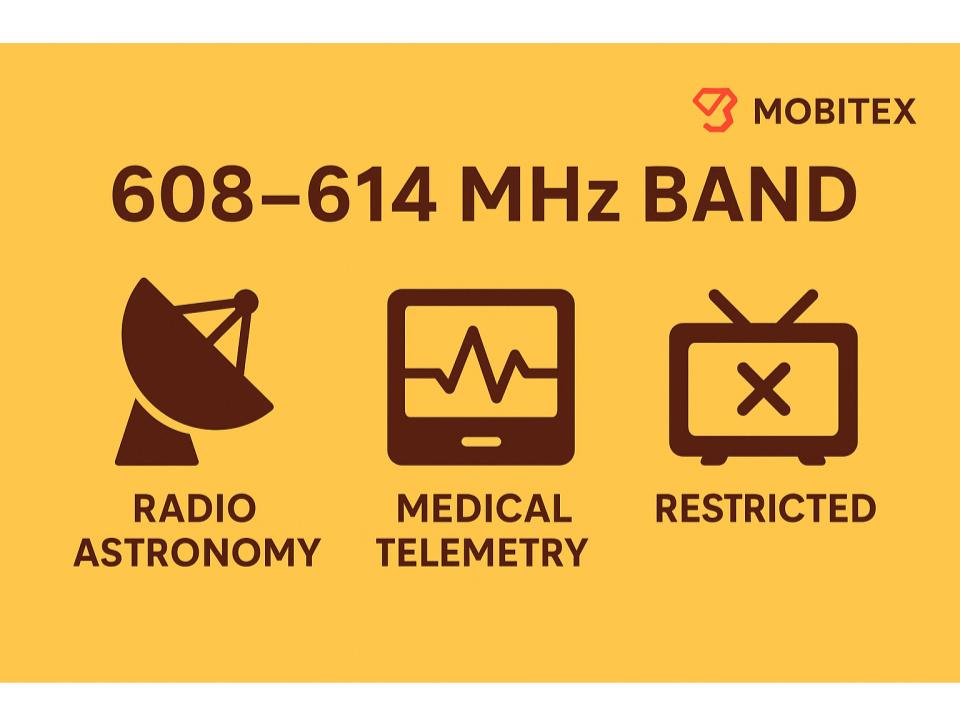The 608–614 MHz band is a very special and tightly controlled portion of the UHF spectrum. Its use varies slightly by region, but it has unique scientific and medical importance rather than mainstream commercial or broadcasting roles.
Primary Applications
🛰️ Radio Astronomy
- The 608–614 MHz band is allocated internationally to radio astronomy.
- It corresponds to the hydroxyl (OH) spectral line region, which scientists use to study galactic and extragalactic emissions, star formation, and interstellar gas.
- Radio telescopes use this band to detect faint natural radio emissions from space — so it’s protected from interference under ITU regulations.
🩺 Medical Telemetry (in some regions, especially North America)
- In the United States and Canada, Wireless Medical Telemetry Systems (WMTS) are authorized to use 608–614 MHz for hospital monitoring applications.
- These systems transmit patient vital signs (e.g., ECG, respiration) wirelessly to centralized monitors.
- The FCC allows this use under strict coordination with the National Telecommunications and Information Administration (NTIA) to prevent interference with radio astronomy.
📡 3. Restricted Spectrum for Broadcasting & Wireless Mics
- Unlike adjacent UHF TV broadcast bands (470–608 MHz and 614–698 MHz), this 6 MHz block is off-limits to commercial broadcasters.
- Wireless microphones, TV white-space devices, and low-power auxiliaries cannot operate here except under highly specific experimental or coordinated conditions.
🌍 Regional Overview
| Region | Primary Use | Notes |
|---|---|---|
| ITU Region 2 (Americas) | Radio astronomy + WMTS | Strictly coordinated between healthcare and science institutions |
| ITU Region 1 (Europe, Africa) | Radio astronomy | Exclusively protected for scientific observation |
| ITU Region 3 (Asia-Pacific) | Radio astronomy | Some countries reserve it entirely for scientific use |
🧭 In Summary
The 608–614 MHz band is reserved for:
- 🔭 Radio astronomy (worldwide)
- 🏥 Medical telemetry (mainly U.S. and Canada)
- 🚫 No commercial broadcasting or wireless mic use
It’s one of the few UHF sub-bands that bridges science and medicine – carefully protected to prevent interference that could compromise astronomical research or hospital patient monitoring.
Frequently Asked Questions
What is WMTS?
WMTS stands for Wireless Medical Telemetry Service.
It’s a dedicated radio service established by the FCC (Federal Communications Commission) in the United States to support medical telemetry applications, such as wireless patient monitoring in hospitals.
Here’s a quick overview:
🏥 Purpose
WMTS allows hospitals and healthcare facilities to transmit patient data (like heart rate, ECG, oxygen levels, etc.) wirelessly from sensors or bedside monitors to centralized nursing stations — without using Wi-Fi or consumer bands that could be prone to interference.
⚙️ Frequency Bands
WMTS uses three frequency ranges in the U.S.:
- 608–614 MHz (shared with radio astronomy, requires coordination)
- 1395–1400 MHz
- 1427–1432 MHz
📡 Why It Exists
Before WMTS, hospitals often used unlicensed spectrum (like 450 MHz or 460 MHz) for telemetry, which led to interference from other users. The FCC created WMTS in 2000 to give medical devices protected, interference-free frequencies.
🧭 Key Features
- Reserved exclusively for medical telemetry
- Operated only by authorized healthcare providers
- Must coordinate with the American Society for Healthcare Engineering (ASHE) to avoid conflicts
- No commercial or public use is allowed
In short, WMTS ensures reliable, interference-protected wireless communication for medical monitoring systems – critical for patient safety in hospitals.

